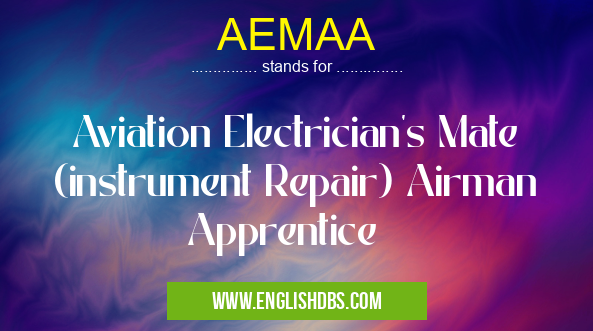What does AEMAA mean in NAVY
AEMAA stands for Aviation Electrician's Mate (Instrument Repair) Airman Apprentice in Governmental contexts. An AEMAA is a service member of the United States military who specializes in the maintenance and repair of electric systems and component on aircrafts. The rank designation of AEMAA is the lowest enlisted rank within the aviation electrician's mate field.

AEMAA meaning in Navy in Governmental
AEMAA mostly used in an acronym Navy in Category Governmental that means Aviation Electrician's Mate (instrument Repair) Airman Apprentice
Shorthand: AEMAA,
Full Form: Aviation Electrician's Mate (instrument Repair) Airman Apprentice
For more information of "Aviation Electrician's Mate (instrument Repair) Airman Apprentice ", see the section below.
» Governmental » Navy
Aviation Electrician's Mate
Aviation electrician’s mates are responsible for performing electrical installations, modifications, tests, inspections, preventive maintenance and troubleshooting on aircraft systems. This includes navigation systems such as gyroscopes and radio communications, as well as instrumentation and computer systems that control different aircraft functions. AEMs must also be knowledgeable about various wiring components such as coils and batteries. They’re also responsible for maintaining aircraft lighting systems both inside and outside the plane, including beacon lights, taxiway lights, landing lights and anti-collision lights.
Role Responsibilities
An AEMAA is typically assigned duties which involve major remodeling of existing equipment or installation of new equipment to make sure that all aircrafts remain fully operational at all times. Routine duties may include coordination with other technicians in order to determine the best course of action for any repairs or modifications. In addition to this they are required to file reports after each modification or repair they perform so that supervisors can track progress over time. To ensure all work is done accurately and efficiently an AEMAA must be well versed in both basic math skills such as algebraic equations as well as safety measures related to working with high voltage current sources found on planes.
Essential Questions and Answers on Aviation Electrician's Mate (instrument Repair) Airman Apprentice in "GOVERNMENTAL»NAVY"
What is the role of an Aviation Electrician's Mate (instrument Repair) Airman Apprentice?
The Airman Apprentice plays an important role in servicing, testing and repairing instruments and electrical systems on aircraft. They diagnose and troubleshoot malfunctions, install new equipment, perform maintenance inspections, assemble wiring harnesses and make adjustments to ensure that aircraft are safely operated.
What type of training do I need to become an Aviation Electrician's Mate (instrument Repair) Airman Apprentice?
An Aviation Electrician's Mate (instrument Repair) Airman Apprentice will need to complete both technical training at a specialized school as well as specific job-related certifications. Training topics may include aviation safety regulations, electronic theory, electrical components, circuit boards, wiring diagrams and instrument repair techniques.
What is expected of me in this position?
As the Aviation Electrician's Mate (instrument Repair) Airman Apprentice you will be responsible for performing routine operations such as inspecting wires for continuity and checking insulation levels of connectors. You will repair and maintain instruments in accordance with manufacturer specifications and use test instruments to locate circuit faults. You must also take active measures to prevent any potential hazardous conditions while handling tools or operating machinery.
What skills should I possess for this position?
A successful candidate should possess excellent problem solving abilities as well as manual dexterity to work with small components. Furthermore, they must have a strong understanding of electronics principles, wiring diagrams and schematics along with the ability to read blueprints accurately. Knowledge in mathematics will also come in handy when performing calculations or making measurements during repairs or maintenance inspections.
Is there potential for advancement within this field?
Absolutely! With experience and dedication it is possible to advance either within one's present unit or gain transferable skills once more senior positions become available such as an Aircraft Electricians Chief Petty Officer or Electronics Technicians Supervisor role where you would lead a team on complex projects.
What are some common tasks undertaken by the Aviation Electrician’s Mate (Instrument Repair)?
In addition to maintaining existing systems aboard aircraft such as navigational computers, guidance systems or communication radios; other common duties may include working with different types of switches and relays; replacing defective microchips; calibrating semi-conductor devices; wiring various circuits; rewiring broken lines; measuring resistance values using test equipment and soldering circuits together etc.
Are there professional qualifications needed?
Yes! An individual wishing to pursue the Aviation Electrician’s Mate (Instrument Repair) role would require a FAA Powerplant Mechanic License along with a valid FCC license which permits them to work on Federal communications equipments legally. Prior experience dealing with military weapons systems such as radar systems may also be beneficial but not essential for all roles.
What challenges can I expect when working on larger aircrafts?
One needs to take into account all environmental factors such as temperature swings inside a large cabin which will affect the performance of some sensitive components located within it’s electrical system architecture which needs rigorous attention at times due to their criticality.
Final Words:
In conclusion, an Aviation Electrician's Mate (Instrument Repair) Airman Apprentice (AEMAA) is an enlisted service member who specializes in maintaining and repairing electrical components found on airplanes. Their roles span from wiring diagrams to inspecting navigation systems that both power an aircraft’s flight operations as well as keep passengers safe while onboard what can possibly be very turbulent flights. Being knowledge not just in aviation electronics but safety measures help keep this position one filled with much needed importance within the aviation industry today.
